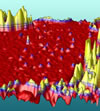 Research Update: The Closer One Looks the Stronger Bone Gets
Research Update: The Closer One Looks the Stronger Bone Gets
Bone is tough on all scales from the millionths down to the billionths of meters, scaling that works cooperatively to resist breakage – until age and disease take their toll, which is why scientists urgently seek to understand just how fracture resistance works. Kurt Koester, Joel Ager, and Robert Ritchie of the Materials Sciences Division, writing in Nature, have discovered that bone is much tougher up close than previously suspected. Their work explains just why bones are more likely to break cross-wise than to split. More>
Campus News: Town Hall Meeting on Cal’s Computational Science and Engineering Program
UC Berkeley recently approved a Designated Emphasis in Computational Science and Engineering, and the educational program was introduced to Berkeley Lab staff at a town-hall-style meeting last Friday. The goal was to build a community of researchers involved in computational science and engineering and explore ideas for Lab-campus cooperation. Those unable to attend who would like to be added to the mailing list for future activities should email Masoud Nikravesh at [email protected]. If there is enough demand, there will be a second town hall meeting.
 In the News: Graphene the Key to Imaging Hydrogen Atoms
In the News: Graphene the Key to Imaging Hydrogen Atoms
Most scientists have studied graphene, the monolayer form of carbon, for its peculiar electronic properties, but Alex Zettl of the Materials Sciences Division and his research group have a new interest in the gossamer net of atoms. “Think of it sort of as a spider web,” says Zettl, “and the atoms you want to view are flies on the spider web” – in this case, hydrogen atoms. Science News writer David Castelvecchi picked up the report, which appeared in last week’s Nature; read his account here>.
People: NERSC Analytics Group Wins “OASCR” at SciDAC Conference
At Electronic Visualization Night at the 2008 SciDAC conference (Scientific Discovery through Advanced Computing) last week in Seattle the audience voted for their favorites among 52 entries. One of the 10 winning OASCRs (named for DOE’s Office of Advanced Scientific Computing Research) went to a new climate-simulation visualization by Prabhat, Janet Jacobsen, Gunther Weber, and Wes Bethel of the NERSC Analytics and CRD Visualization Group and Christopher Kerr and Venkatramani Balaji of the Modeling Services Group at NOAA’s Geophysical Fluid Dynamics Laboratory. More about SciDAC 2008>.
 Employee News: Next Week is Last Chance for Water World Tickets
Employee News: Next Week is Last Chance for Water World Tickets
Next Tuesday will be the last chance to purchase discount tickets for general adult/child one-day admission to Water World in Concord for $20.00 each (normally $29.99), and to Discovery Kingdom for $27.00 each (normally $39.99). To buy tickets please bring your Berkeley Lab employee ID and a check or exact cash to the cafeteria lobby, where a representative will be on duty July 29 from 11:30 a.m. to 1:00 p.m. The tickets are good on any day during the 2008 park operations. Contact [email protected] for more information.
